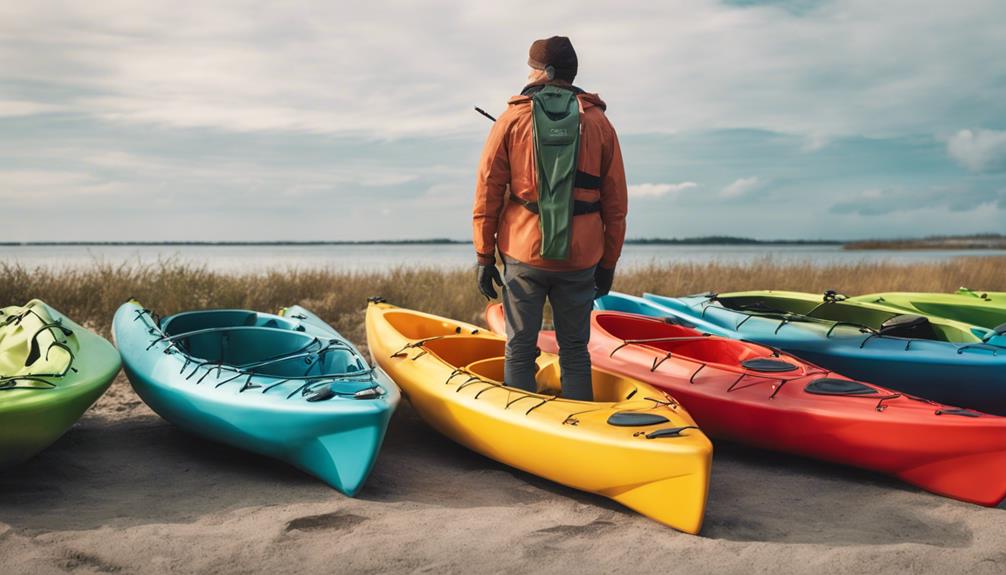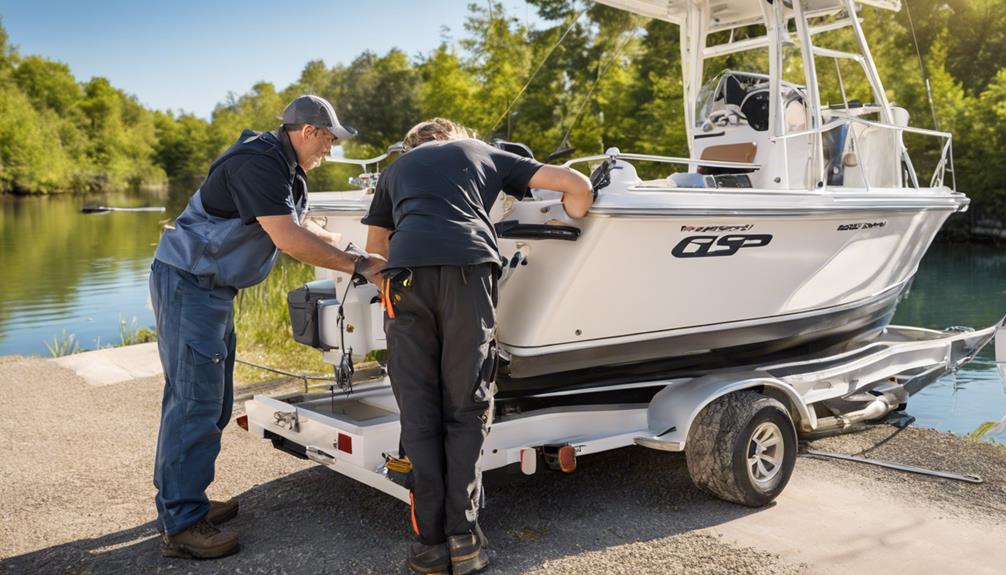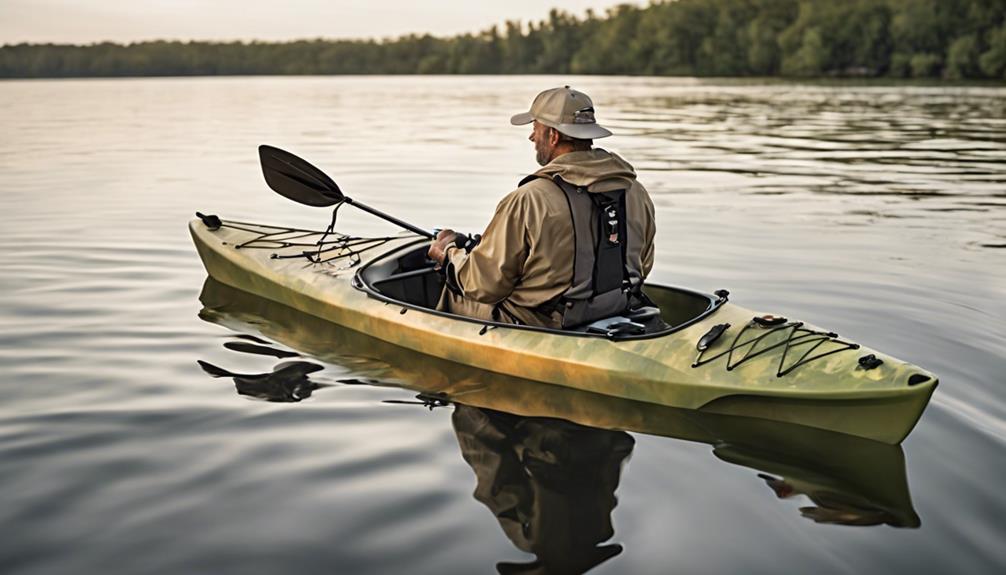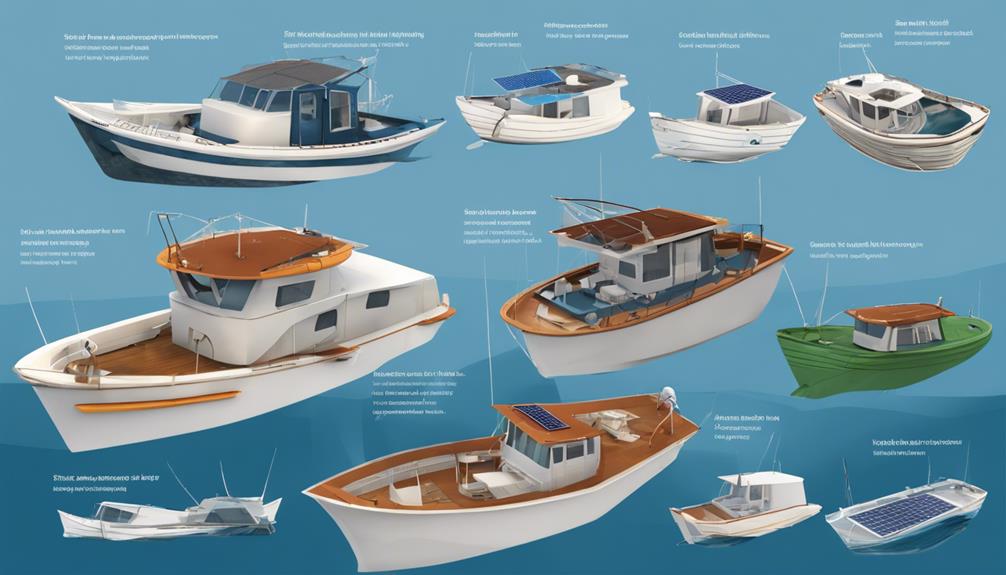When it comes to selecting the perfect fishing kayak for your adventures in 2023, it's crucial to navigate through a sea of options with finesse.
Picture yourself gliding through serene waters, the gentle hum of nature surrounding you as you cast your line. But how will you ensure your vessel matches your ambitions on the water?
Stay tuned for expert advice on essential factors that will steer you towards the ideal fishing kayak for your needs this year.
Kayak Type Considerations
When choosing a fishing kayak, consider the type that best suits your needs and preferences. There are two primary considerations to keep in mind: paddle vs. pedal kayaks and sit-on-top vs. sit-inside kayaks.
Paddle kayaks are the traditional choice and offer a more hands-on experience. They provide a great workout as you navigate the waters using a paddle. Paddle kayaks are often preferred by anglers who enjoy the simplicity and control that comes with paddling. On the other hand, pedal kayaks are becoming increasingly popular for fishing. These kayaks are propelled using pedals, allowing for hands-free operation. This feature can be beneficial when you need to focus on fishing without worrying about paddling.
When it comes to the design of the kayak, you also need to decide between sit-on-top and sit-inside kayaks. Sit-on-top kayaks are more stable and easier to get in and out of, making them a good choice for beginners. They also provide more freedom of movement, which can be beneficial when fishing. Sit-inside kayaks, on the other hand, offer better protection from the elements and can keep you drier in rough waters.
Ultimately, the choice between paddle and pedal kayaks, as well as sit-on-top and sit-inside kayaks, will depend on your personal preferences and fishing style. Take the time to consider what'll work best for you before making a decision.
Weight Capacity Assessment
Considering the weight capacity of a fishing kayak is crucial to ensure safe and efficient outings on the water. When evaluating the weight capacity of a fishing kayak, there are several key factors to keep in mind:
- Load Capacity: Understanding the maximum weight a kayak can support is essential for a comfortable and safe fishing experience.
- Weight Distribution: Properly distributing the weight of yourself, gear, and any additional accessories is vital for stability and maneuverability.
- Gear Weight: Take into account the weight of your fishing gear, cooler, tackle boxes, and any other items you plan to bring along.
- User Weight: Remember to factor in your own weight along with the weight of any potential fishing partners or passengers.
Storage Features Evaluation
To ensure you have adequate space for all your fishing essentials, evaluating the storage features of a fishing kayak is essential. When looking at storage options, consider kayaks with waterproof compartments. These compartments are crucial for keeping your valuables dry and safe while out on the water. Whether it's your phone, wallet, or keys, having waterproof storage can provide peace of mind and ensure your items stay protected from any water splashes or unexpected rain.
In addition to waterproof compartments, pay attention to the kayak's gear organization features. Having well-thought-out gear organization can make your fishing experience more enjoyable and efficient. Look for kayaks that offer ample storage for your tackle boxes, fishing rods, bait, and any other equipment you may need. Some kayaks come with built-in rod holders, tackle box compartments, and bungee cords to secure larger gear items. These features can help you stay organized on the water and prevent clutter in your kayak.
Stability and Balance Check
Ensure your fishing kayak maintains stability and balance for a safe and enjoyable experience on the water. When choosing a fishing kayak, conducting a stability test and balance assessment is crucial to ensure you feel secure while casting your line.
Here are some key points to consider:
- Width: Opt for a wider kayak as it typically provides more stability, especially for beginners or those who value balance.
- Hull Design: Look for kayaks with a flat hull or a pontoon-style design as they tend to offer better stability on the water.
- Weight Capacity: Check the weight capacity of the kayak to ensure it can support you and your gear without compromising stability.
- Primary vs. Secondary Stability: Consider whether you prefer primary stability (initial steadiness) or secondary stability (resistance to tipping) based on your fishing style and comfort level.
Propulsion System Selection
For a smooth fishing experience, evaluating different propulsion systems can enhance your time on the water. When choosing a fishing kayak, consider whether you prefer motorized options or manual paddling. Motorized kayaks are ideal for covering longer distances with less effort, making them suitable for anglers who want to explore larger bodies of water or conserve energy for fishing. These kayaks are often equipped with electric motors that can be controlled easily, allowing you to focus on fishing rather than paddling.
On the other hand, manual paddling offers a more traditional kayaking experience. Kayaks propelled by paddles provide a good workout and are quieter than motorized options, which can be advantageous when fishing in calm waters or areas where noise might scare off fish. Manual paddling also allows for greater maneuverability and control, making it easier to navigate tight spots or areas with obstacles.
When deciding between motorized and manual propulsion systems, think about your fishing style, the type of water you'll be navigating, and how much physical effort you want to exert while kayaking. Some kayaks even offer the versatility of switching between motorized and manual propulsion, giving you the best of both worlds. Ultimately, the propulsion system you choose should align with your fishing preferences and enhance your overall experience on the water.
Comfort and Seating Inspection
When inspecting the comfort and seating of a fishing kayak, prioritize assessing the ergonomic design and adjustability for optimal support during long fishing trips. Ensuring your comfort while out on the water is crucial for an enjoyable fishing experience.
Here are some key points to consider:
- Seat Adjustment: Look for fishing kayaks that offer adjustable seating options. Being able to customize the seat position can help you find the most comfortable setup for your body type and preferences.
- Back Support: A fishing kayak with excellent back support is essential for preventing discomfort or pain during extended fishing outings. Consider kayaks with high-back seats or built-in lumbar support.
- Padding Quality: Check the quality of the seat padding. Well-padded seats can provide extra cushioning and enhance overall comfort, especially when spending long hours sitting in the kayak.
- Seat Material: Consider the material of the seat. Durable and breathable materials are ideal for withstanding outdoor conditions and ensuring ventilation to prevent sweating and discomfort.
Material Durability Analysis

Inspect the material durability of fishing kayaks to ensure long-lasting performance in various water conditions. When evaluating a fishing kayak, pay close attention to the material strength of the hull. High-density polyethylene (HDPE) is a popular choice for its durability and resistance to impacts from underwater obstacles. This material can withstand scrapes and knocks, making it ideal for rougher waters. Fiberglass kayaks are known for being lightweight and agile, but they may be more prone to damage compared to HDPE. Consider the type of water you'll be fishing in to determine the level of material strength required for your kayak.
Conduct a longevity assessment by examining how well the kayak handles prolonged exposure to sunlight and saltwater. UV-resistant materials are crucial to prevent fading and weakening of the kayak structure over time. Additionally, corrosion-resistant hardware and fittings can prolong the kayak's lifespan, especially if you plan on saltwater fishing. Look for kayaks with reinforced seams and joints for added durability, ensuring that the kayak can withstand the rigors of frequent fishing trips.
Budget and Value Comparison
Considering your fishing needs and financial constraints, finding a fishing kayak that offers the best value within your budget is key. When comparing different options, it's essential to look beyond the price tag and consider factors like brand reputation and customer reviews. Here are some tips to help you make a well-informed decision:
- Brand Reputation: Look for fishing kayak brands known for their quality and durability. A reputable brand is more likely to offer a kayak that meets your fishing needs and lasts for a long time.
- Customer Reviews: Check out what other anglers are saying about the fishing kayaks you're interested in. Real-life experiences shared in customer reviews can give you valuable insights into the performance and reliability of the kayak.
- Value for Money: Consider not just the upfront cost but also the features and durability you're getting for the price. A slightly more expensive kayak that offers better performance and longevity may be a better investment in the long run.
- Warranty Coverage: Review the warranty terms offered by different kayak manufacturers. A solid warranty can provide you with peace of mind knowing that you're protected in case of any manufacturing defects or issues.
Frequently Asked Questions
What Are Some Common Maintenance Tips for Keeping a Fishing Kayak in Top Condition?
To keep your fishing kayak in top shape, make sure to regularly clean it with mild soap and water. This helps prevent dirt and grime buildup.
Practice safety measures by always wearing your life jacket and checking your equipment before each trip.
Proper storage in a dry, shaded area can extend the life of your kayak.
Lastly, maintain your equipment by checking for wear and tear and replacing parts as needed.
Are There Any Specific Regulations or Permits Required for Using a Fishing Kayak in Certain Locations?
When it comes to fishing kayaks, it's essential to know about permit requirements and location regulations.
Some areas may require permits to fish from a kayak, and specific locations might have rules about fishing equipment or catch limits.
Always check local regulations before heading out on the water to ensure you're in compliance.
How Can I Properly Transport and Store a Fishing Kayak When Not in Use?
When it comes to properly storing and transporting your fishing kayak, you want to ensure it remains in good shape. Proper storage means keeping it in a cool, dry place away from direct sunlight.
For transportation, secure it well on your vehicle using kayak straps or a roof rack.
Regular maintenance, like cleaning and checking for any damages, will help keep your kayak in top condition for your next fishing adventure.
Are There Any Recommended Accessories or Add-Ons That Can Enhance the Fishing Experience While Using a Kayak?
When enhancing your fishing experience on a kayak, consider storage solutions like tackle boxes and dry bags to keep your gear organized and protected.
Comfort accessories like padded seats, adjustable footrests, and backrests can make long days on the water more enjoyable.
Look for rod holders, fish finders, and anchor systems as add-ons that can help improve your fishing game while paddling.
Customize your kayak with these accessories to optimize your fishing trips.
What Safety Precautions Should Be Taken When Fishing From a Kayak, Especially in Different Weather Conditions or Water Environments?
When fishing from a kayak, remember safety first. Always wear your safety gear and be aware of changing weather conditions.
Brush up on your paddling techniques to navigate smoothly. Learn emergency procedures in case something goes wrong.
Stay vigilant, especially in different water environments. Enjoy your fishing experience, but prioritize your safety above all else.
Conclusion
Now that you have considered all the important factors for choosing the best fishing kayak of 2023, you're ready to make an informed decision. Remember to prioritize your needs and preferences, such as kayak type, weight capacity, storage features, stability, propulsion system, comfort, material durability, and budget.
By following these tips, you can ensure that you select a fishing kayak that will enhance your fishing experience and provide you with countless hours of enjoyment on the water. Happy fishing!



